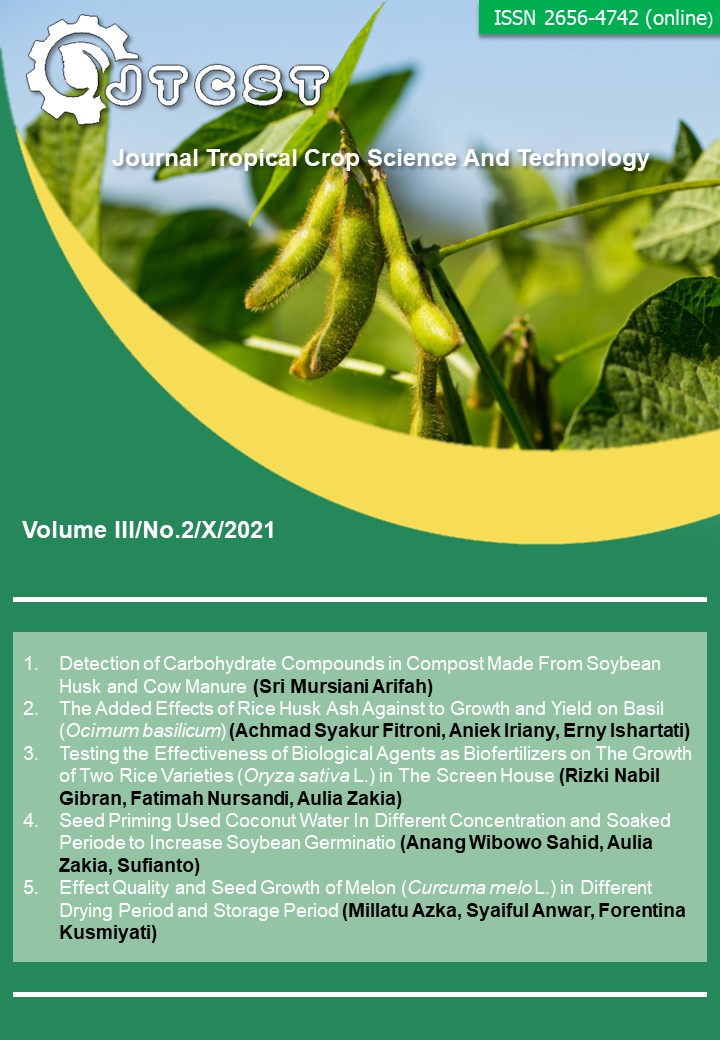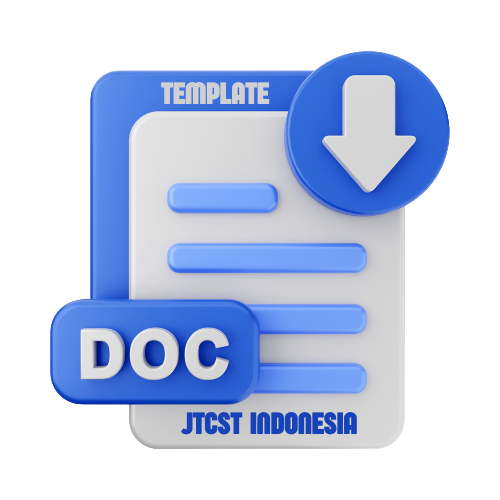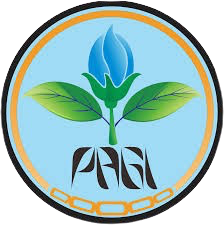Quality and Seed Growth of Melon (Curcuma melo L.) in Different Drying Period and Storage Period
DOI:
https://doi.org/10.22219/jtcst.v3i2.14490Keywords:
drying period, germination, melon seed, seed moisture content, storage period,Abstract
The objective of this research was to study the effect of drying and storage period on seed quality and seed growth of melon (Curcuma melo L.). This research was assigned in Nested Design with first factor was storage period (P1 = 0 week, P2 = 2 weeks, P3 = 4 weeks, dan P4 = 6 weeks) and drying period (L1 = 0 hours, L2 = 12 hours, dan L3 = 24 hours). Parameter observed were seed moisture content, seed germination, seed maximum growth potency, length of plants, and number of leaves. The result showed that drying period showed significant affect on seed moisture content. Storage period showed significant affect on seed germination, seed maximum growth potency, and length of plants. Both storage period and drying period didn’t show significant affect on the number of melon leaves.
Downloads
References
Cardoso, A. I. I., A. Z. Kronka, N. B. L. Lanna, P. N. L. Silva, L. F. Colombari, P. L. Santos dan C. G. Pierozzi. (2015). Germination, vigor, and fungi incidence in melon seeds treared with Thiabendazole. African Journal of Agricultural Research, 10 (35), 3472–3476.
Fajrina, H. N. dan Kuswanto. (2019). Uji viabilitas benih melon (Curcuma melo L.) pada berbagai taraf waktu penyimpanan buah dan pengeringan biji. Plantropica Journal of Agrocultural Science, 4 (1), 19–29.
Ginting, A. P., A. Barus, dan R. Sipayung. (2017). Pertumbuhan dan produksi melon (Curcumis melo L.) terhadap pemberian pupuk NPK dan pemangkasan buah. Jurnal Agroekoteknologi FP USU, 5 (4), 786–798.
Hasanah, M. (2002). Peran mutu fisiologik benih dan pengembangan industry benih tanaman industri. J. Litbang Pertanian, 21 (3), 84–91.
Huda, A. N., W. B. Suwarno, dan A. Maharijaya. (2017). Keragaman genetik karakteristik buah antar 17 genotip melon (Curcuma melo L.). Jurnal Hortikultura, 8 (1), 1–12.
Indriana, K. R. (2016). Pengaruh waktu penyimpanan benih dan konsentrasi larutan asam sulfat terhadap viabilitas dan vigor benih jarak (Jatropha curcas Linn) di persemaian. PASPALUM, 4 (2), 23–30.
Koyoto, O., Haryati, dan E. Purba. (2017). Pengaruh lama pengeringan dan lama perendaman dalam krioprotektan terhadap viabilitas benih rosella (Hibiscus sabdariffa L.) secara kriopreservasi. Jurnal Agroekoteknologi, 5 (4), 752–767.
McCormack, J. H. (2010). Seed Processing and Storage: Principles and Practice. Versi 1.6. USDA-CREES (Cooperative State Research, Education, and Extension Service), Washington DC, US.
Novita, N. dan F. C. Suwarno. (2014). Viabilitas benih melon (Curcumis melo L.) pada kondisi optimum dan sub-optimum setelah diberi perlakuan invigorasi. Buletin Agrohorti, 2 (1), 59 – 65.
Sutopo, L. (2004). Teknologi Benih. Jakarta, Indonesia: Raja Grafindo Perkasa.
Triadiati, M. Muttaqin, dan N. S. Amalia. (2019). Pertumbuhan, produksi, dan kualitas buah melon dengan pemberian pupuk silika. Jurnal Ilmu Pertanian Indonesia (JIPI), 24 (4), 366–374.
Unga, N. T., M. Anshar, dan S. Laude. (2020). Pengaruh dosis pupuk bokashi terhadap pertumbuhan dan hasil tanaman melon (Curcumis melo L.). e-Journal Agrotekbis, 8 (1), 38 – 45
Downloads
Published
How to Cite
Issue
Section
License
Copyright (c) 2021 Millati Azka, Syaiful Anwar, Florentina Kusmiyati

This work is licensed under a Creative Commons Attribution-ShareAlike 4.0 International License.
Authors who publish with this journal agree to the following terms:
- Authors retain copyright and grant the journal right of first publication with the work simultaneously licensed under a Creative Commons Attribution License that allows others to share the work with an acknowledgement of the work's authorship and initial publication in this journal.
- Authors are able to enter into separate, additional contractual arrangements for the non-exclusive distribution of the journal's published version of the work (e.g., post it to an institutional repository or publish it in a book), with an acknowledgement of its initial publication in this journal.
- Authors are permitted and encouraged to post their work online (e.g., in institutional repositories or on their website) prior to and during the submission process, as it can lead to productive exchanges, as well as earlier and greater citation of published work (See The Effect of Open Access).











